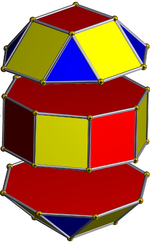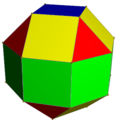
Elongated square gyrobicupola
Encyclopedia
In geometry
, the elongated square gyrobicupola or pseudorhombicuboctahedron is one of the Johnson solid
s (J37). The 92 Johnson solids were named and described by Norman Johnson in 1966.
(J29) and inserting an octagonal prism
between its two halves. The resulting solid is locally vertex-regular — the arrangement of the four faces incident on any vertex is the same for all vertices; this is unique among the Johnson solids. However, it is not truly vertex-transitive
, and consequently not one of the Archimedean solid
s, as there are pairs of vertices such that there is no isometry of the solid which maps one into the other. Essentially, two types of vertices can be distinguished by their "neighbors of neighbors." Another way to see that the polyhedron is not vertex-regular is to note that there is exactly one belt of eight squares around its equator, which distinguishes vertices on the belt from vertices on either side.
The solid can also be seen as the result of twisting one of the square cupola
e (J4) on a rhombicuboctahedron
(one of the Archimedean solid
s; a.k.a. Elongated Square Orthobicupola) by 45 degrees. Its similarity to the rhombicuboctahedron gives it the alternative name pseudorhombicuboctahedron. It has occasionally been referred to as "the fourteenth Archimedean solid".
There are 8 (green) squares around its equator
, 4 and 4 (yellow) squares above and below, and one (blue) square on each pole.
Geometry
Geometry arose as the field of knowledge dealing with spatial relationships. Geometry was one of the two fields of pre-modern mathematics, the other being the study of numbers ....
, the elongated square gyrobicupola or pseudorhombicuboctahedron is one of the Johnson solid
Johnson solid
In geometry, a Johnson solid is a strictly convex polyhedron, each face of which is a regular polygon, but which is not uniform, i.e., not a Platonic solid, Archimedean solid, prism or antiprism. There is no requirement that each face must be the same polygon, or that the same polygons join around...
s (J37). The 92 Johnson solids were named and described by Norman Johnson in 1966.
Relation to Rhombicuboctahedron
As the name suggests, it can be constructed by elongating a square gyrobicupolaSquare gyrobicupola
In geometry, the square gyrobicupola is one of the Johnson solids . Like the square orthobicupola , it can be obtained by joining two square cupolae along their bases...
(J29) and inserting an octagonal prism
Prism (geometry)
In geometry, a prism is a polyhedron with an n-sided polygonal base, a translated copy , and n other faces joining corresponding sides of the two bases. All cross-sections parallel to the base faces are the same. Prisms are named for their base, so a prism with a pentagonal base is called a...
between its two halves. The resulting solid is locally vertex-regular — the arrangement of the four faces incident on any vertex is the same for all vertices; this is unique among the Johnson solids. However, it is not truly vertex-transitive
Vertex-transitive
In geometry, a polytope is isogonal or vertex-transitive if, loosely speaking, all its vertices are the same...
, and consequently not one of the Archimedean solid
Archimedean solid
In geometry an Archimedean solid is a highly symmetric, semi-regular convex polyhedron composed of two or more types of regular polygons meeting in identical vertices...
s, as there are pairs of vertices such that there is no isometry of the solid which maps one into the other. Essentially, two types of vertices can be distinguished by their "neighbors of neighbors." Another way to see that the polyhedron is not vertex-regular is to note that there is exactly one belt of eight squares around its equator, which distinguishes vertices on the belt from vertices on either side.
 Rhombicuboctahedron |
 Exploded sections |
 Pseudo-rhombicuboctahedron |
The solid can also be seen as the result of twisting one of the square cupola
Square cupola
In geometry, the square cupola, sometimes called lesser dome, is one of the Johnson solids . It can be obtained as a slice of the rhombicuboctahedron...
e (J4) on a rhombicuboctahedron
Rhombicuboctahedron
In geometry, the rhombicuboctahedron, or small rhombicuboctahedron, is an Archimedean solid with eight triangular and eighteen square faces. There are 24 identical vertices, with one triangle and three squares meeting at each. Note that six of the squares only share vertices with the triangles...
(one of the Archimedean solid
Archimedean solid
In geometry an Archimedean solid is a highly symmetric, semi-regular convex polyhedron composed of two or more types of regular polygons meeting in identical vertices...
s; a.k.a. Elongated Square Orthobicupola) by 45 degrees. Its similarity to the rhombicuboctahedron gives it the alternative name pseudorhombicuboctahedron. It has occasionally been referred to as "the fourteenth Archimedean solid".
Symmetry
With faces colored by its D4d symmetry, it can look like this:| pseudorhombicuboctahedron | Pseudo-deltoidal icositetrahedron Dual polyhedron Dual polyhedron In geometry, polyhedra are associated into pairs called duals, where the vertices of one correspond to the faces of the other. The dual of the dual is the original polyhedron. The dual of a polyhedron with equivalent vertices is one with equivalent faces, and of one with equivalent edges is another... |
|
|---|---|---|
 net |
 |
There are 8 (green) squares around its equator
Equator
An equator is the intersection of a sphere's surface with the plane perpendicular to the sphere's axis of rotation and containing the sphere's center of mass....
, 4 and 4 (yellow) squares above and below, and one (blue) square on each pole.

